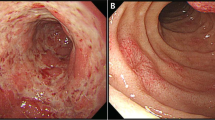Abstract
We describe a 10-year-old boy with acquired Helicobacter pylori infection and simultaneous angioedema which is a rare but life-threatening condition. Our patient was hospitalised with generalised angioedema and severe circulatory shock due to extreme loss of fluids and proteins into interstitial tissues (weight gain 10 kg within 2 days, extreme haemoconcentration – haemoglobin 206 g/l, haematocrit 0.570, leucocytosis 18,300 /µl, high lactate 13.8 mmol/l) and simultaneous failure of the complement system (C3 <0.16 g/l, C4 <0.13 g/l, CH50 45 U/ml, i.e. 50% of normal value, C1 inhibitor 0.21 g/l at the lower limit). All possible known causes of angioedema were excluded (infection, allergy, auto-immune disease, NSAIDs, lymphoproliferative disease) except for the simultaneous H. pylori infection which was proven serologically and histologically. Eradication therapy led to a complete remission of the H. pylori infection. An absence of angioedema and the restoration of the complement system was later observed. To the best of our knowledge, no similar case report of a child has yet been published. Conclusion: Helicobacter pylori infection should be considered in the development of angioedema in childhood.
Similar content being viewed by others
References
Agostoni A, Cicardi M (1992) Hereditary and acquired C1-inhibitor deficiency: biological and clinical characteristics in 235 patients. Medicine 71: 206–215
Farkas H, Gyeney L, Majthényi P, Füst G, Varga L (1999) Angioedema due to acquired C1-esterase inhibitor deficiency in a patient with Helicobacter pylori infection. Z Gastroenterol 37: 513–518
Farkas H, Füst G, Fekete B, Karádi I, Varga L (2001) Eradication of Helicobacter pylori and improvement of hereditary angioneurotic oedema. Lancet 358: 1695–1696
Gasbarrini A, Franceschi F, Gasbarrini G, Pola P (1997) Extra-intestinal pathology associated with Helicobacter infection. Eur J Gastroenterol Hepatol 9: 231–233
Heymann WR (2001) Angioedema, acquired. eMed J 2: 1-7www.emedicine.com/DERM/topic23.htm
Ojetti V, Armuzzi A, De Luca A, Nucera E, Franceschi F, Candelli M, Zannoni GF, Danese S, Di Caro S, Vastola M, Schiavino D, Gasbarrini G, Patriarca G, Pola P, Gasbarrini A (2001) Helicobacter pylori infection affects eosinophilic cationic protein in the gastric juice of patients with idiopathic chronic urticaria. Int Arch Allergy Immunol 125: 66–72
Sykora J, Varvarovska J, Kuntscherova J, Stozicky F, Martin de Lassalle E, Gottrand F, Vincent P (2002) Comparison of epidemiological and clinical symptoms and chronic gastritis in Helicobacter pylori infected children in two geographically different populations (Czech Republic, France). Czech Slov Pediatr 57: 47–52
Wedi B, Wagner S, Werfel T, Manns MP, Kapp A (1998) Prevalence of Helicobacter pylori-associated gastritis in chronic urticaria. Int Arch Allergy Immunol 116: 288–294
Wisniewski RM, Peura DA (1997) Helicobacter pylori: beyond peptic ulcer disease. Gastroenterologist 5: 295–305
Author information
Authors and Affiliations
Corresponding author
Rights and permissions
About this article
Cite this article
Varvarovska, J., Sykora, J., Stozicky, F. et al. Acquired angioedema and Helicobacter pylori infection in a child. Eur J Pediatr 162, 707–709 (2003). https://doi.org/10.1007/s00431-003-1250-7
Published:
Issue Date:
DOI: https://doi.org/10.1007/s00431-003-1250-7




